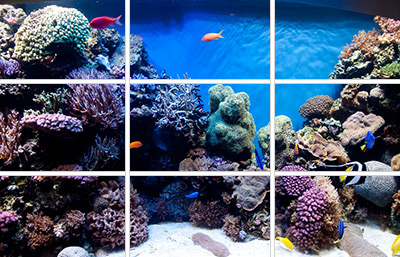Aficionados of freshwater planted aquariums have long understood that observing certain rules of composition when aquascaping with plants, rocks, driftwood, and other features can have a tremendous impact on an aquarium’s overall aesthetic impression. While we reefkeepers haven’t traditionally placed much emphasis on composition in our aquascaping approach—at least not in a formal sense—we can certainly enhance our enjoyment of the hobby by implementing some of these same rules. Among these is the “Rule of Thirds.”
To apply the Rule of Thirds, imagine that a grid pattern consisting of two equidistant vertical lines and two equidistant horizontal lines is superimposed over the front of your tank. This grid creates nine equal-sized, rectangular sections and visually divides the image in front of you into thirds both vertically and horizontally. Picture that famous image at the beginning of The Brady Bunch TV series (sans the Bradys and Alice, of course), and you’ll have the general idea.

Great, so you’ve got a mental grid floating in front of your tank and the theme to The Brady Bunch running in a constant loop through your head. Now what? Well, according to the Rule of Thirds, compositional elements—for our purposes, aquascaping elements and sessile invertebrates—should be placed along the grid lines and strong focal points should be positioned at points where the lines intersect. For our purposes, a strong focal point could be a particularly impressive coral specimen, a prominent rock projection, etc.
Why position aquascaping elements in this manner? After all, shouldn’t prominent visual features be placed front and center in the tank? On the contrary, when viewing an image (whether it’s an aquarium, photograph, painting, or simply a real-life scene in front of us), the human eye isn’t naturally drawn to its center. Rather, it’s drawn to those areas where the grid lines intersect. Thus, though it may seem counterintuitive, aquascaping according to the Rule of Thirds—with features offset from the center—appears more natural and aesthetically pleasing and utilizes negative space to its best advantage.

Note that the size of the tank will influence how many focal points you can use before they begin to compete visually with one another and muddle the composition. With smaller tanks, you may be limited to one prominent feature.
Of course, this “rule” has no bearing whatsoever on the success of a reef system or the health and well-being of its inhabitants. It’s purely a matter of aesthetics. Also, implementing this rule in a dynamic reef aquarium is not without its challenges because you have to factor in the future growth of sessile invertebrates in determining ideal placement. And don’t even get me started on how hard it is to train fish to hold still at those points of intersection!
Still, aquascaping according to the Rule of Thirds can help maximize the aesthetic impact of a reef system, so some hobbyists might find that it’s worth the additional effort.



